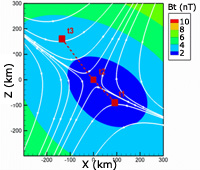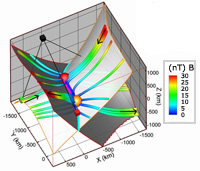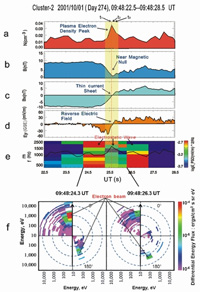Electron trapping within reconnection
11 August 2008
A 3-dimensional (3-D) "magnetic snapshot" of the heart of a magnetic reconnection region has been obtained in-situ by the four satellites of the ESA Cluster mission, at one-third of the distance to the Moon from Earth. The snapshot, constructed using a new analysis method, reveals for the first time a 3-D magnetic structure known as a magnetic null pair where two reconnection sites, or nulls, are magnetically linked. The rare occurrence of one of the Cluster satellites passing by one null of the pair has uncovered a new phenomenon where the electrons are temporarily trapped around that null. The electron trapping may ultimately lead to the formation of energetic electron beams, a well-known but poorly understood consequence of reconnection.
These breakthroughs in the study of 3-D magnetic reconnection have been published in the Journal of Geophysical Research (16 May 2008) and Geophysical Research Letters (29 July 2008).
Up until now, no method has been able to identify a pair of magnetic nulls simultaneously. A first attempt to detect such a null pair was reported last year by Xiao et al. in Nature Physics (see also: Cluster unveils a new 3D vision of magnetic reconnection). Based on Cluster observations, characteristics of two nulls identified at two different time instances were gathered to infer the properties of the combined null pair under the strong assumption that the characteristics of the null identified first remained unchanged until the second null was observed.
 |
|
Figure 2 Cluster C2 (red solid cube) moves across the X-line shown on a 2-D cross-section of the magnetic field configuration on 1 October 2001. |
In a paper published in the 29 July 2008 issue of Geophysical Review Letters (GRL), Dr. He (Peking University, China) and colleagues present for the first time the simultaneous identification of a magnetic null pair (see Figure 1) using a newly developed method which is detailed in a paper published in the Journal of Geophysical Research last May.
This 3-D magnetic snapshot also reveals that the Cluster C2 satellite passed close to one magnetic null (see Figure 2). This very rare occurrence provided a first opportunity to obtain rather detailed in-situ measurements of the physics in the inner reconnection region for such a magnetic configuration. In particular, simultaneous measurements of an electron density peak, an enhancement of high frequency electrostatic waves, as well as bi-directional energetic electron beams along the magnetic field (see Figure 3) were obtained.
The theoretical implications of these findings are addressed in the GRL paper. The authors suggest a new scenario of electron dynamics in the null region: the thermal electrons are trapped in a cusp-like magnetic cavity in the inner region around the magnetic null pair. This electron trapping may be the cause of important reconnection electron dynamics such as electron acceleration, drifting and enhanced reconnection rate.
"These results significantly improve our understanding of the 3-D reconnection process with a null pair structure. The observations and suggested scenario pave the way for future studies on reconnection, not only for space physicists but also for the astrophysical and laboratory plasmas communities, since the chance of such in-situ measurements is expected to be very rare", says Prof. Tu, Peking University, China, co-author of the papers.
"The results will also provide a valuable reference for the NASA Magnetospheric Multiscale (MMS) mission and the ESA Cross-Scale mission. A primary goal of these future missions is to measure the 3-D geometry of the inner reconnection region. The results reported in GRL present new observations and an associated scenario in such a region for the first time", wrote Prof. Zong from Peking University and University of Massachusetts (Lowell, USA), co-author of the papers.
"This is indeed precisely the aim of the Cross-Scale mission: studying the heart of magnetic reconnection by measuring the electron scale near the null with four spacecraft, as well as studying ion and fluid scales", says Philippe Escoubet, ESA Cluster project scientist and Cross-Scale study scientist.
Related Publications
He, J.-S., et al., (2008a), "Electron trapping around a magnetic null", Geophys. Res. Lett., 35, L14104, 29 July 2008, DOI:10.1029/2008GL034085
He, J.-S., et al., (2008b),"A magnetic null geometry reconstructed from Cluster spacecraft observations", J. Geophys. Res., 113, A05205, 16 May 2008, DOI:10.1029/2007JA012609
Related article
Xiao, C. J., et al., "Satellite Observations of Separator Line Geometry of Three-Dimensional Magnetic Reconnection", Nature Physics 3, 609-613, 24 June 2007, DOI:10.1038/nphys650
Contacts
J.-S. He, School of Earth and Space Sciences, Peking University, Beijing 100871, China
Email: jshept pku.edu.cn
pku.edu.cn
Q.-G. Zong
School of Earth and Space Sciences, Peking University Beijing 100871, China & Center for Atmospheric Research, University of Massachusetts Lowell, Lowell, MA 01854-3629, USA
Email: qgzong gmail.com
gmail.com
C.-Y. Tu, School of Earth and Space Sciences, Peking University, China
Email: chuanyitu pku.edu.cn
pku.edu.cn
Web story editors
Arnaud Masson, Science Directorate, ESA, The Netherlands.
Arnaud.Masson esa.int, phone: +31-71-565-5634
esa.int, phone: +31-71-565-5634
Philippe Escoubet, Science Directorate, ESA, The Netherlands.
Philippe.Escoubet esa.int, phone: +31-71-565-4564
esa.int, phone: +31-71-565-4564
Matt Taylor, Science Directorate, ESA, The Netherlands.
mtaylor rssd.esa.int, phone: +31-71-565-8009
rssd.esa.int, phone: +31-71-565-8009



